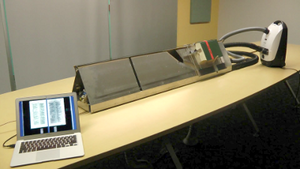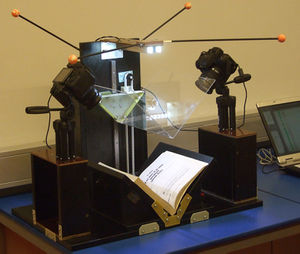A public library of our own: Building feminist digital libraries
From Gender and Tech Resources
Revision as of 12:55, 20 September 2019 by XavCC (Talk | contribs) (→Wrapping up: add redirection link for Calibre)
How can I make materials rare or at risk available to others? How can I digitize books, fanzines, posters? How can I organise the printed materials my organisation and/or community are producing? Where can I find e-books? If you have one or several of those questions in mind, this how-to is for you!
Building feminist digital libraries
Public Libraries can be defined as one of those universal social innovation that benefits everyone. When truly public they can be places where all people can get access to knowledge independently of their sociodemographic, gender, cultural and professional characteristics. It’s one of those almost invisible infrastructures that we start to notice when they go extinct and we begin to miss their fundamentally inclusive and distributive nature. On the other side, Internet has completely changed our expectations and imagination about a universal access to all available knowledge for every member of society. Nowadays many public libraries are either being closed down, either cannot acquire digital books from the world’s largest publishers. Here we present four steps to become a librarian and start with others your own digital public library. Before shaping your own work flow and choosing your tools, keep in mind that public libraries are defined by a free access to books for every member of society, a catalog of books and a librarian. With books ready to be shared, meticulously cataloged, everyone is a librarian. When everyone is librarian, libraries are everywhere.
Case study: A feminist library on Memory of the world
There are many waves into feminist thinking and its theorization. This diversity is due to an intense history of social movements and struggles for gender social justice around the world and across time. Accordingly, it can be difficult to understand the many perspectives and sometimes confronting points of views. Building and sharing catalog of books on the public domain or under open or free licenses can strength your work and activism within you communities, with your allies and the people you are trying to reach out. Public libraries support a better understanding of feminism(s) and what you stand for, your motivations, how you organise, the related (collective and historical) memories you build upon and the aesthetics and imaginaries you are shaping. For more information visit the feminist library in Memory of the world.
Methodology
First Step: Digitizing books with a book scanner
You can skip this step and still become a librarian and build your own public digital library. However keep in mind that your community or organization might be filled with valuable documents that might disappear if they are never digitized, for instance fanzines, posters and flyers, call for actions, old books not edited anymore, local archives etc.
Scanning of the book: You can use a scanner or build your own bookscanner depending of time, resources and energies.
Second Step: Postproduction of scanned images
You can use ScanTailor which is free software available for Windows and gnu/Linux. It is an interactive post-processing tool for scanned pages. It performs operations such as page splitting, deskewing, adding/removing borders, and others. You give it raw scans, and you get pages ready to be printed or assembled into a PDF or DJVU file.
Then in order to transform images into proper texts you can use software for achieving an Optical Character Recognition (OCR). This is a method of digitizing printed texts so they can be edited, searched, stored, displayed on-line. One of the most common software to achieve OCR is Abbyy Finereader which is proprietary and available for Windows and Mac OS. There is also a free software version called Tesarac and you can use it for instance from Gscan2pdf.
Third step: Developing your catalog of e-books
You can use Calibre which a free software available for all OS and enables to catalog your books, add and download from internet related metadata (author, categories, ISBN, language, cover etc), transfer files to an e-book reader, converting formats (from emob to epub for instance), managing sub-libraries, serving books in a local network and sharing books catalogs in Internet with the [let’s share books] plugin.
Fourth step: Finding e-books and articles online
You can use curated repositories in order to find electronic books such as:
Aaaaarg.org: An online repository with over 50,000 books and texts. It was created by the artist Sean Dockray and serves as a library for the Public School – an online platform that supports offline autodidactic activities. Website Archived here : https://archive.fo/F9V6z
UbuWeb: Is the largest non-profit online archive of avant-garde art. It was created and is co-ordinated by the artist Kenneth Goldsmith. It is a curated repository. It offers visual, concrete and sound poetry, expanding to include film and sound art mp3 archives. Website Archive here : https://web.archive.org/web/20180429151110/https://ubu.com/
Monoskop: Is a wiki, blog and a repository aggregating, documenting and mapping works, artists and intiatives related to the avant-gardes, media arts and theory and activism. Initially it focused on Eastern and Central Europe.
Memory of the world: Compiles and make available on Internet many interesting curated catalog of books using Calibre. Most of the books deal with information and communication theories, marxism, feminism, philosophy etc.
Libgen: Library Genesis is an online repository with over a million of user-contributed books and is the first project in history to offer everyone on the Internet free download of its entire book collection (as of this writing, about 15 Tb of data), together with the all metadata and code for webpages.
Wrapping up
Wrapping up, when you notice that someone asks for a book you can use ebooks repositories to find it, use Calibre to catalog that book, and use [let’s share books] to share it online. If you notice that some particular book on those repositories needs an extra care to split the double pages, or is only composed by scanned images, then you can make an OCR of it and upload it back on those repositories and/or make it available through your catalog of books.




